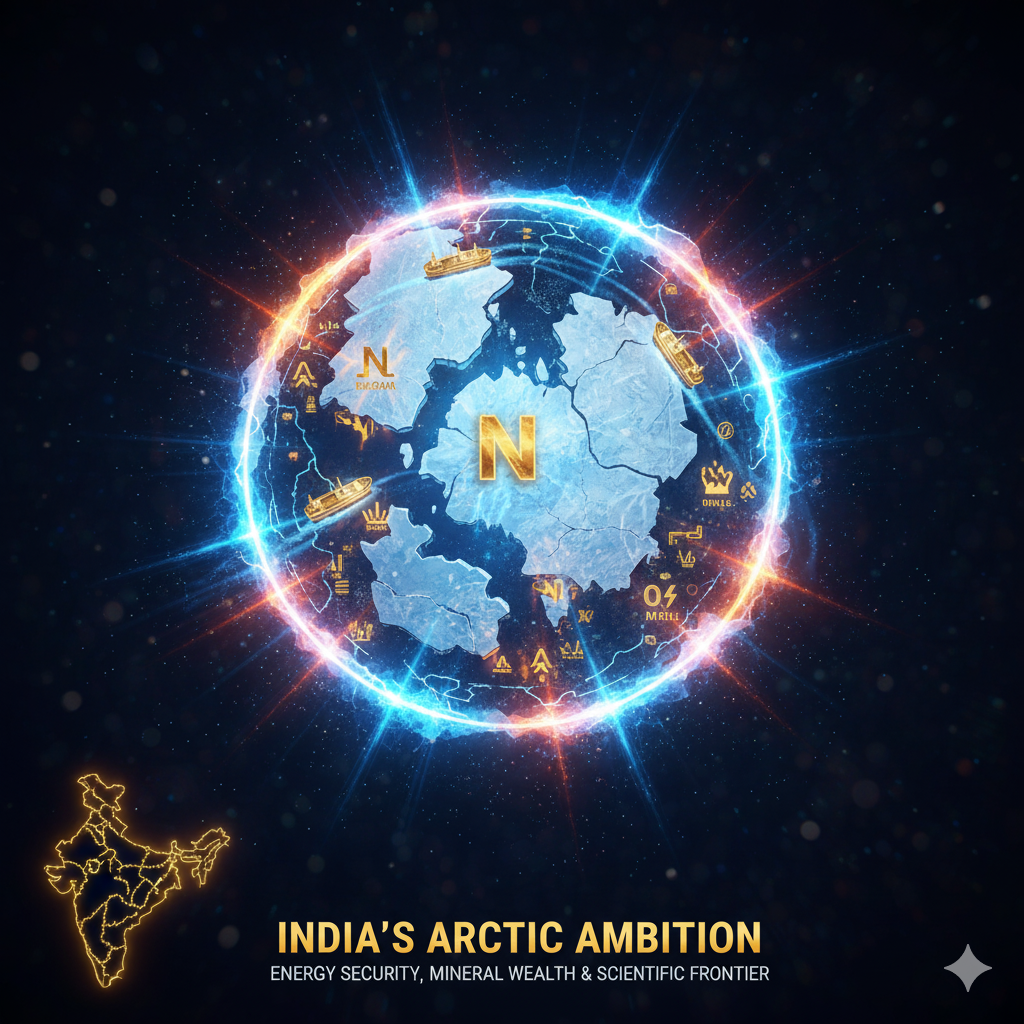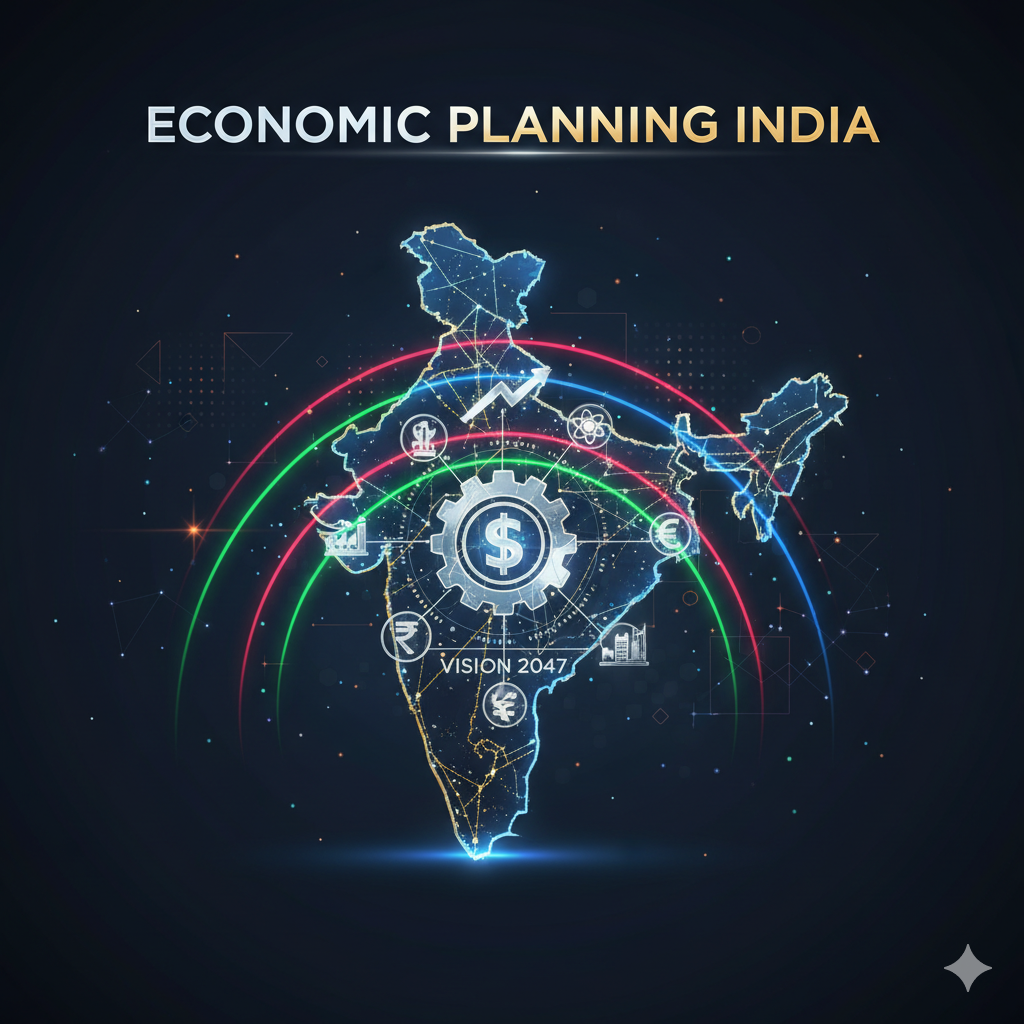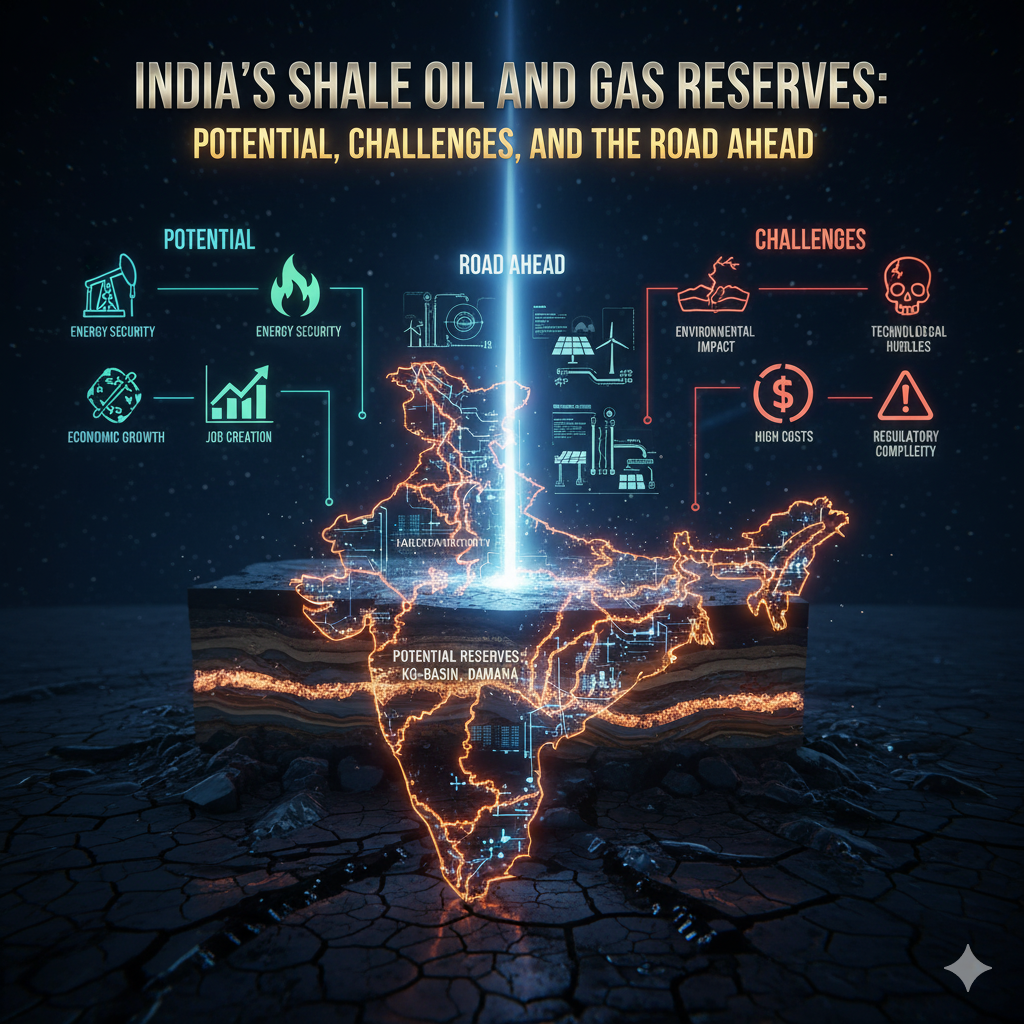Introduction
The Arctic region, once considered a frozen and inaccessible frontier, is rapidly emerging as a critical area of global interest. Due to the accelerating impact of climate change, ice sheets and glaciers in the Arctic are melting at unprecedented rates, exposing vast reserves of untapped natural resources and opening new maritime trade routes. For countries like India, which is not geographically part of the Arctic, the region still holds immense significance due to its implications for energy security, economic development, environmental balance, and geopolitical influence. India’s interest in the Arctic is not new; it began its engagement more than a decade ago, but in recent years, this interest has intensified because of the changing global order and the strategic opportunities that the Arctic presents.
The Arctic Region: An Overview
The Arctic region comprises the area surrounding the North Pole, covering parts of eight countries—Canada, Denmark (through Greenland), Finland, Iceland, Norway, Russia, Sweden, and the United States (through Alaska). It is home to vast ice sheets, unique ecosystems, indigenous communities, and, importantly, enormous reserves of oil, gas, minerals, and rare earth elements. The Arctic also plays a vital role in regulating the Earth’s climate, as it functions like a “cooling system” for the planet by reflecting solar radiation. However, rising global temperatures have led to dramatic changes in the Arctic landscape, causing significant geopolitical, economic, and environmental shifts.
India’s Arctic Policy and Engagement
India formally laid down its Arctic Policy in March 2022, under the title “India’s Arctic Policy: Building a Partnership for Sustainable Development.” This policy framework outlines India’s vision for scientific research, sustainable development, climate action, and cooperation with Arctic nations. India has also been a permanent observer in the Arctic Council since 2013, which allows it to contribute to discussions on governance, sustainable use of resources, and environmental protection.
India’s interest is guided by several pillars:
- Science and Research – Understanding climate change, glaciology, and biodiversity.
- Environmental Protection – Studying impacts on ecosystems and communities.
- Economic and Resource Development – Exploring energy and trade opportunities.
- Strategic and Geopolitical Engagement – Enhancing India’s role in global governance.
Why the Arctic Matters to India
1. Energy Security
India is one of the world’s fastest-growing energy consumers, heavily dependent on imports to meet its oil and gas requirements. The Arctic is believed to hold nearly 13% of undiscovered oil reserves and 30% of undiscovered natural gas reserves globally. Access to these reserves could significantly diversify India’s energy supply sources. Collaborations with Arctic nations, particularly Russia, offer India opportunities for investment in exploration and extraction. With global energy markets becoming unstable due to geopolitical conflicts, the Arctic presents a potential long-term solution for India’s energy security.
2. Mineral and Rare Earth Resources
The Arctic is also rich in rare earth elements, uranium, gold, zinc, and platinum, which are crucial for India’s industrial growth, defense manufacturing, and emerging technologies such as renewable energy systems and electronics. At present, India relies heavily on imports from a limited number of countries for rare earths, making its supply chain vulnerable. The Arctic could help diversify these sources and strengthen India’s technological base.
3. New Maritime Routes and Trade Opportunities
The melting of Arctic sea ice is opening new maritime pathways such as the Northern Sea Route (NSR), which reduces the travel distance between Asia and Europe by nearly 40% compared to the Suez Canal route. For India, a country dependent on international trade, this could mean reduced costs, faster shipping, and less reliance on congested sea lanes. Additionally, Arctic ports could emerge as hubs for global logistics, and India would benefit from being part of this new trade geography.
4. Climate Change and Environmental Concerns
Though resource opportunities are important, India is also deeply concerned about the environmental consequences of Arctic melting. The Arctic plays a direct role in regulating the South Asian monsoon, which is the lifeline of India’s agriculture. Rapid Arctic warming disrupts global ocean currents and weather patterns, directly affecting rainfall in India. Therefore, India’s scientific research in the Arctic is not just academic but vital for its food and water security.
5. Geopolitical and Strategic Interests
The Arctic is becoming a new arena of global competition, with major powers like the United States, Russia, China, and European countries asserting influence. China has declared itself a “near-Arctic state” and launched the Polar Silk Road initiative. For India, participation in Arctic governance and partnerships with like-minded countries is essential to balance Chinese influence and to ensure an inclusive framework for resource use. Strengthening ties with Russia, a key Arctic power, also helps India secure its energy interests.
6. Scientific and Technological Research
India has maintained a research station in Svalbard, Norway, called Himadri, since 2008, where studies on atmospheric science, glaciology, and marine biology are conducted. India has also deployed its scientists in Arctic expeditions to monitor climate change and its links with the Indian Ocean and monsoon. Such research helps India develop predictive models for weather and climate, which are crucial for disaster management and agricultural planning.
India’s Ongoing Initiatives in the Arctic
- Himadri Research Station – Located in Svalbard, it serves as India’s permanent research base for Arctic studies.
- INDARC Observatory – Set up in Kongsfjorden, it monitors Arctic fjord dynamics and their relation to climate.
- Arctic Expeditions – India regularly sends research teams to study biodiversity, oceanography, and atmospheric conditions.
- Collaboration with Russia – India has engaged in discussions with Russia for joint exploration of Arctic energy projects, particularly in Siberia and the Russian Arctic shelf.
- International Partnerships – India works with Norway, Sweden, and other countries for scientific cooperation and sustainable resource management.
Opportunities for India in the Arctic
- Energy Diversification – Reducing reliance on Middle Eastern oil and gas.
- Rare Earth Access – Supporting India’s electronic and defense industries.
- Trade Efficiency – Benefiting from shorter shipping routes.
- Climate Insights – Strengthening India’s role in global climate research.
- Global Influence – Positioning India as a responsible stakeholder in polar governance.
Challenges for India in the Arctic
Despite these opportunities, India faces several challenges in its Arctic engagement.
- Geographical Distance – India is far from the Arctic, making physical access costly and logistically complex.
- High Infrastructure Costs – Exploration and shipping in icy conditions require advanced technology and huge investments.
- Geopolitical Competition – The Arctic is already dominated by powers like Russia, the US, and China, making India’s role relatively limited.
- Environmental Concerns – Resource exploitation in the Arctic could worsen ecological degradation, raising questions about sustainability.
- Legal and Institutional Barriers – The governance of the Arctic is guided by international laws and the Arctic Council, where India’s role is still limited as an observer.
Way Forward for India
For India to strengthen its Arctic engagement, a balanced approach is required—one that aligns economic interests with environmental responsibilities.
- Strengthen Research and Development – Expand scientific missions and establish collaborations with global institutes.
- Strategic Partnerships – Deepen ties with Russia, Norway, and other Arctic powers for joint exploration.
- Promote Sustainable Practices – Support eco-friendly technologies and renewable energy solutions in Arctic projects.
- Enhance Maritime Infrastructure – Invest in polar shipping technologies to utilize new trade routes.
- Global Governance Role – Advocate for equitable use of Arctic resources through multilateral forums.
Conclusion
India’s keen interest in the resources of the Arctic region stems from a mix of economic needs, strategic aspirations, and environmental responsibilities. As the world transitions into a new era where the Arctic plays a pivotal role, India cannot afford to remain a passive observer. Its engagement must balance energy and trade opportunities with sustainability and global climate commitments. By actively participating in Arctic research, building strong partnerships, and contributing to responsible governance, India can secure its national interests while also promoting global stability.
The Arctic, though far from India’s borders, is deeply connected to its future—through monsoon patterns, energy security, rare earth access, and trade networks. Thus, India’s growing involvement in the region is not just a matter of choice but of necessity in shaping its long-term economic and strategic destiny.




